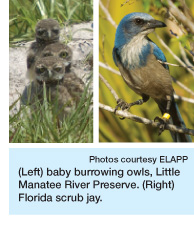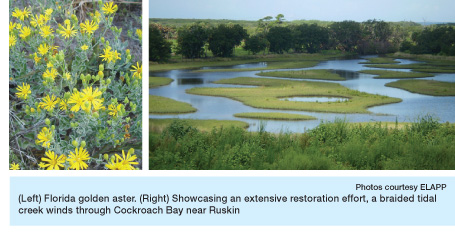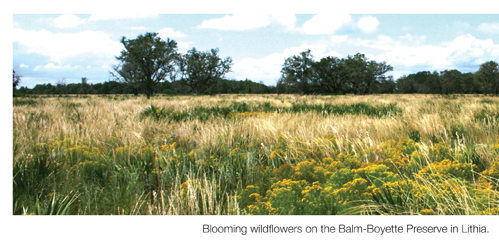 |
||||||||
Campaign for Hillsborough Land Conservation Referendum Heats Up
By Mary Kelley Hoppe
 Bob Martinez is back on the campaign trail, this time stumping for renewal of a Hillsborough County tax to purchase conservation lands. The Nov. 4 ballot referendum to extend the Environmental Lands Acquisition and Protection Program, known as ELAPP, faces some uphill battles, among them a crowded ballot, a presidential contest and a sagging economy. But supporters, including former Florida Governor Martinez, who served as Tampa’s mayor from 1986 to 1990, are confident voters will approve the referendum.
Bob Martinez is back on the campaign trail, this time stumping for renewal of a Hillsborough County tax to purchase conservation lands. The Nov. 4 ballot referendum to extend the Environmental Lands Acquisition and Protection Program, known as ELAPP, faces some uphill battles, among them a crowded ballot, a presidential contest and a sagging economy. But supporters, including former Florida Governor Martinez, who served as Tampa’s mayor from 1986 to 1990, are confident voters will approve the referendum.
“I have every reason to believe the measure will pass,” said Martinez.
Martinez, a Republican, and Democrat Jan Platt, a former Hillsborough County Commissioner who came up with the idea for the land conservation program when she led the county commission in the 1980s, are co-chairs of a citizens committee to rally support for the ballot referendum. The two are busy speaking to civic clubs and groups and helping to raise money for a campaign to boost awareness of the program.
An overwhelming 71% of residents voted to establish the land conservation program through a quarter-mil property tax in 1988. Two years later, nearly 73% of voters approved supporting land purchases with up to $100 million in bond financing. Since then, ELAPP has spent $128 million and leveraged more than $76 million in state funds to purchase more than 44,000 acres of environmentally sensitive lands that are enjoyed each year by thousands of hikers, cyclists, canoeists and wildlife enthusiasts.
Boosters like Platt credit the program’s success to its untarnished administrative track record and citizen involvement.
“This is a program that has not been laced by controversy,” Platt said. “And it’s unique in that it’s citizen-based – citizens review the proposals and any citizen can nominate a property.”
That success, Platt acknowledges, may be one reason ELAPP is not better known.
The squeaky-clean program has stayed out of the media spotlight, which may be one reason a poll conducted earlier this year found that 67% of respondents had never heard of ELAPP. That, and an influx of 324,000 new residents since the 1990 referendum, means supporters will need to work hard to publicize the land purchase program and its benefits to residents.
A “yes” vote on the November referendum will allow the county to continue to protect native wildlife habitat, drinking water sources, and the water quality of rivers, lakes and bays, without increasing the annual tax burden on property owners. If approved, the county will have the authority to issue bonds in an amount up to $200 million, payable through existing ad valorem taxes.
Thanks to the foresight of voters who approved the referendum in 1990, 51 tracts of environmentally sensitive lands have already been permanently preserved through ELAPP. While many sites are located in southern Hillsborough County, conservation parcels have been protected throughout the county. In Northwest Hillsborough County, the 1,100-acre Brooker Creek Headwaters Nature Preserve provides critical protection for the Brooker Creek watershed, which drains to Tampa Bay and encompasses an 8,500-acre nature preserve that straddles Hillsborough and Pinellas counties. The sanctuary features pine flatwoods, oak hammocks, cypress swamp and threatened plants such as the hooded pitcher and southern pine lily.
 North of downtown Tampa, the 12-acre River Tower Park provides urban access and protects water quality in the Hillsborough River, the city’s source of drinking water. In Northeast Tampa, the county and Southwest Florida Water Management District protect and manage a 2,500-acre sensitive ecological network of floodplain, flatwoods, mesic forests and upland islands surrounding Cypress Creek, a major tributary of the Hillsborough River that is classified as an Outstanding Florida Waterway.
North of downtown Tampa, the 12-acre River Tower Park provides urban access and protects water quality in the Hillsborough River, the city’s source of drinking water. In Northeast Tampa, the county and Southwest Florida Water Management District protect and manage a 2,500-acre sensitive ecological network of floodplain, flatwoods, mesic forests and upland islands surrounding Cypress Creek, a major tributary of the Hillsborough River that is classified as an Outstanding Florida Waterway.
With a dwindling amount of natural lands and encroaching growth and urban sprawl, preserving what’s left of natural Florida should remain a priority, according to Platt. “Unless environmentally sensitive lands are purchased now they will be lost,” she says. “Those lands include shorelines, water recharge areas and places of natural beauty, so we’re really creating a legacy for our children and grandchildren.”
“I remember when the county had barely a hundred thousand residents and now we have almost 1.2 million,” adds Martinez. “We need to preserve these green spaces before they’re gone.”
Both Pasco and Pinellas counties also have voter-approved land conservation programs.
Martinez and Platt believe the current “buyers” real estate market makes it an ideal time for the county to be shopping for opportunities to increase conservation land holdings. The thought is that more landowners will step forward and be willing to negotiate on price.
ELAPP sites are open to the public for foot traffic, says Pete Fowler, longtime division manager with the Hillsborough County Parks Department, though not all have a designated access point. With the goal of offering passive recreation on as many sites as possible, “we work closely with local groups that want to establish nature trails, bike trails and equestrian trails,” Fowler says.
 Population
Population
Pressures Reveal What’s at Stake
Florida’s natural lands and waters are the backbone of the state’s prosperity, bringing billions of dollars in economic benefits to the state each year.
Forests, rivers and creeks, and coastal waters are invaluable to fish and wildlife, and to our own quality of life.
 But recent predictions indicate that the state’s population may double in the next 50 years. If that happens, as a study by 1000 Friends of Florida suggests, 7 million acres of Florida lands could be converted from rural and natural to urban land uses – a land size equivalent to the state of Vermont, replacing the rich diversity our current landscape offers and impacting our coastal waters.
But recent predictions indicate that the state’s population may double in the next 50 years. If that happens, as a study by 1000 Friends of Florida suggests, 7 million acres of Florida lands could be converted from rural and natural to urban land uses – a land size equivalent to the state of Vermont, replacing the rich diversity our current landscape offers and impacting our coastal waters.
Of that, nearly 3 million acres of existing agricultural lands and 2.7 million acres of native habitat would be claimed by roads, shopping malls and subdivisions. More than 630,000 acres of land currently under consideration for conservation would be lost, and more than 2 million acres within one mile of existing conservation lands would be developed, “complicating their management and isolating some conservation holdings in a sea of urbanization,” according to the study.
If current trends continue, the Central Florida region, including Hillsborough County, will expand dramatically to include almost continuous development from St. Petersburg to Daytona Beach. By 2060, the only undeveloped land could be small areas of Polk, Lake, Osceola and Sumter counties, mostly due to their distance from transportation corridors and existing wetland conditions. Nearly all the natural systems and wildlife corridors will be fragmented, if not replaced, by urban development.
In Hillsborough County, the ELAP program has identified an additional 45,000 acres of environmentally sensitive lands for protection. “It’s critical that we remain competitive as part of an overall growth management dynamic to provide conservation alternatives,” says Heidi McCree, a south Tampa resident and former chairperson of the Southwest Florida Water Management District Governing Board. “Continuing ELAPP will provide Hillsborough County’s private landowners with conservation options and incentives, enabling us to preserve natural areas for the benefit of future generations.”
“I am a native of Florida and I’ve seen mangrove islands turned into condominiums,” says Platt. “The only way to save land in the state is for the government to buy it,” she adds, noting that the natural environment is what draws people to Florida.
“I think the public understands that.”
